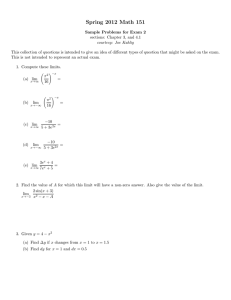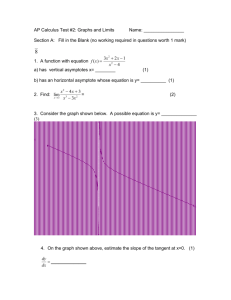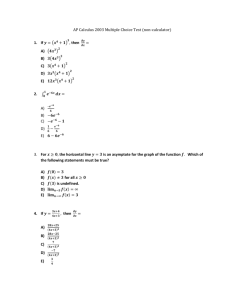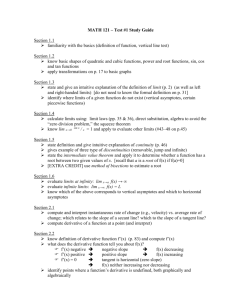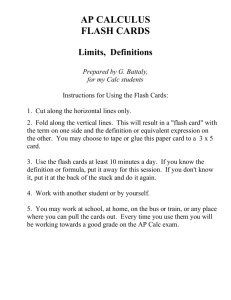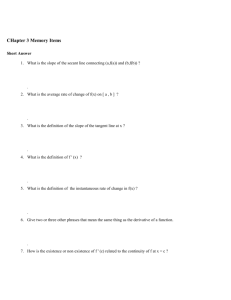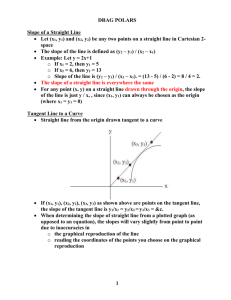AP Calculus AB/BC Final Exam Review Sheet
advertisement
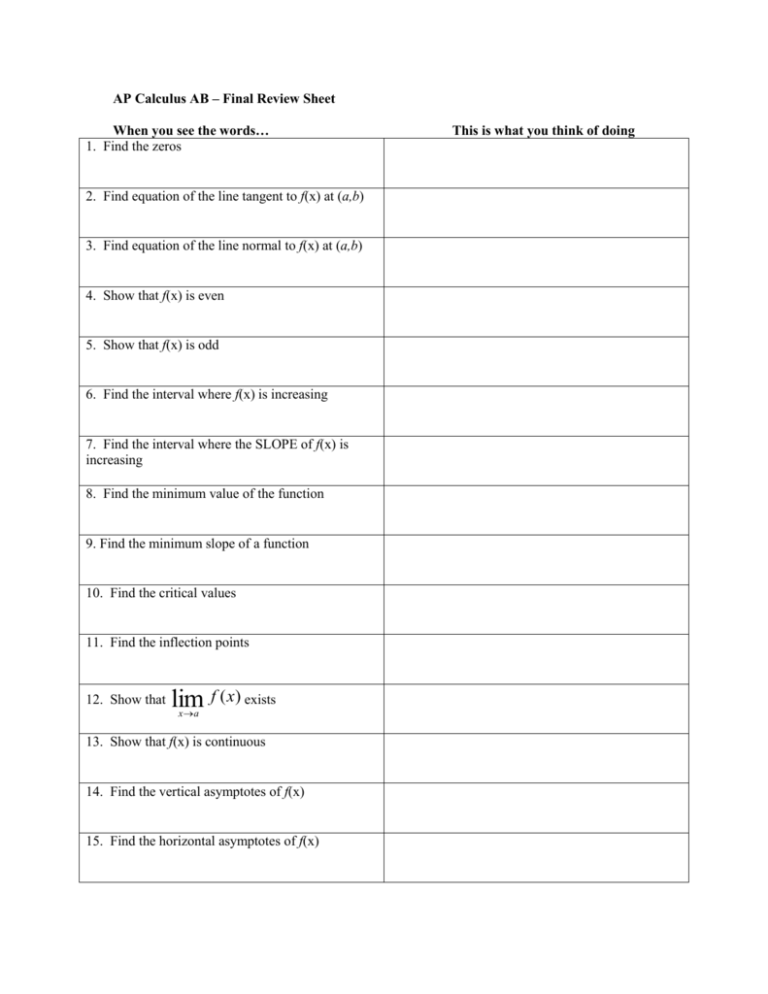
AP Calculus AB – Final Review Sheet When you see the words… 1. Find the zeros 2. Find equation of the line tangent to f(x) at (a,b) 3. Find equation of the line normal to f(x) at (a,b) 4. Show that f(x) is even 5. Show that f(x) is odd 6. Find the interval where f(x) is increasing 7. Find the interval where the SLOPE of f(x) is increasing 8. Find the minimum value of the function 9. Find the minimum slope of a function 10. Find the critical values 11. Find the inflection points 12. Show that lim f ( x) exists x a 13. Show that f(x) is continuous 14. Find the vertical asymptotes of f(x) 15. Find the horizontal asymptotes of f(x) This is what you think of doing 16. Find the average rate of change of f(x) on [a,b] 17. Find instantaneous rate of change of f(x) at a. 18. Find the average value of f(x) on [a,b] 19. Find the absolute maximum of f(x) on [a,b] 20. Show that a piecewise function is differentiable at the point a where the function rule splits 21. Given s(t) (position function), find v(t) 22. Given v(t), find i) displacement and ii)distance the particle travels on [a,b] 23. Find the average velocity of a particle on [a,b] 24. Given v(t), determine if a particle is speeding up at t = k 25. Given v(t) and s(0), find s(t) 26. Show that Rolle’s Theorem holds on [a,b] 27. Show that Mean Value Theorem holds on [a,b] 28. Find domain of f(x) 29. Find the range of f(x) on [a,b] 30. Find the range of f(x) on (, ) 31. Find f ‘ (x) by definition 32. Find the derivative of inverse to f(x) at x = a 33. y is increasing proportionally to y 34. Find the line x = c that divides the area under f(x) on [a,b] into two equal areas x 35. d f (t )dt dx a u d 36. f (t )dt dx a 37. The rate of change of population is… 38. The line y = mx + b is tangent to f(x) at (a,b) 39. Find the area using left Reimann sums 40. Find the area using right Reimann sums 41. Find the area using midpoint rectangles 42. Find the area using trapezoids 43. Solve the differential equation… x 44. Meaning of f (t )dt a 45. Given a base, cross sections perpendicular to the x-axis are squares, find the volume 46. Find where the tangent line to f(x) is horizontal 47. Find where the tangent line to f(x) is vertical 48. Find the minimum acceleration given v(t) 49. Approximate the value of f(0.1) by using the tangent line to f at x = 0 50. Given the value of f(a) and the fact that the anti-derivative of f is F, find F(b) 51. Find the derivative of f (g (x)) , f ( x) , and g ( x) f(x)g(x) b 52. Given b f ( x)dx , find [ f ( x) k ]dx a a 53. Given a picture of f ‘(x), find where f(x) is increasing 54. Given v (t ) and s(0), find the greatest distance from the origin of a particle on [a,b] 55. Given a water tank with g gallons initially being filled at a rate of F(t) gallons/min and emptied at the rate of E(t) gallons/min on [t1,t2], find a) the amount of water in the tank at m minutes 56. b) the rate the water amount is changing at m 57. c) the time when the water is at a minimum 58. Given a chart of x and f(x) on selected values between a and b, estimate f ‘(c) where c is between a and b 59. Given dy , draw a slope field dx 60. Find the area between f(x), g(x), on [a,b] 61. Find the volume if the area between f(x), g(x) is rotated about the x-axis 62. Given a base, cross sections perpendicular to the x-axis are equilateral triangles, find the volume 63. Given a base, cross sections perpendicular to the x-axis are semi-circles, find the volume 64. Given s(t) (position) of a particle, find when the particle has increasing speed. 65. Find the volume if the area between f(x), g(x) is rotated about the line y = a 66. Find the volume when the area between y = f(x),x = 0, y = 0, is rotated about the y-axis 67. Find f ( x) lim g ( x) if lim x x f ( x) lim g ( x) 0 x 68. Given f(x), find arc length on [a,b] AP Calculus BC – Final Review Sheet When you see the words… 1. Find f ( x)dx 0 2. dP k dP P P( M P) or kP1 dt M dt M 3. Find x 2 dx where x 2 ax b factors ax b 4. The position vector of a particle moving in the plane is r (t ) x(t ), y(t ) a) Find the velocity 5. b) Find the acceleration 6. Find the speed This is what you think of doing 7. Given the velocity vector v(t ) x(t ), y(t ) and the position at time 0, a) find the position vector 8. b) When does the particle stop? 9. c) Find the acceleration vector at t1 10. Find the area inside the polar curve r f ( ) 11. Find the slope of the tangent line to the polar curve r f ( ) 12. Use Euler’s method to approximate f(1.2) given dy , ( x0 , y 0 ) (1,1) , and x 0.1 dx 13. Is the Euler’s approximation an underestimate or an overestimate? x 14. Find n e ax dx where a, n are integers 15. Write a series for x n cos x where n is an integer 16. Write a series for ln(1+x) centered at x = 0 17. 1 n n 1 p converges if … 18. If f ( x) 2 6 x 18 x 2 54 x 3 ... , find 1 f 2 19. Find the interval of convergence of a series 20. Let S4 be the sum of the first 4 terms of an alternating series for f(x). Approximate f ( x) S 4 (n 1)n! 21. Suppose f n ( x) . Write the first n 2 four terms and the general term of a series for f(x) centered at x = c 22. Given a Taylor series, find the Lagrange form of the remainder for the nth term where n is an integer at x = c x2 x3 23. f ( x) 1 x ... 2! 3! 24. f ( x) x x3 x5 (1) n x 2 n1 ... ... 3! 5! (2n 1)! 25. f ( x) 1 26. Find x2 x4 x6 (1) n x 2 n ... ... 2! 4! 6! (2n)! (sin x) m (cos x) n dx where m and n are integers 27. Given x f (t ) , y g (t ) , find dy dx 28. Given x f (t ) , y g (t ) , find d2y dx 2 29. x f (t ) , y g (t ) , find the arc length on [t1,t2]. 30. Find horizontal tangents to a polar curve r f ( ) 31. Find vertical tangents to a polar curve r f ( ) 32. Given a set of points, estimate the volume under the curve using Simpson’s rule on [a,b]. 33. Find the dot product: u1 , u 2 v1 , v2 34. Multiply two vectors:
